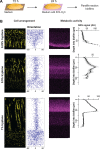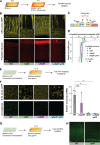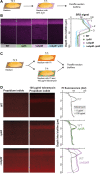This is a preprint.
Cell arrangement impacts metabolic activity and antibiotic tolerance in Pseudomonas aeruginosa biofilms
- PMID: 37645902
- PMCID: PMC10462148
- DOI: 10.1101/2023.06.20.545666
Cell arrangement impacts metabolic activity and antibiotic tolerance in Pseudomonas aeruginosa biofilms
Update in
-
Cellular arrangement impacts metabolic activity and antibiotic tolerance in Pseudomonas aeruginosa biofilms.PLoS Biol. 2024 Feb 1;22(2):e3002205. doi: 10.1371/journal.pbio.3002205. eCollection 2024 Feb. PLoS Biol. 2024. PMID: 38300958 Free PMC article.
Abstract
Cells must access resources to survive, and the anatomy of multicellular structures influences this access. In diverse multicellular eukaryotes, resources are provided by internal conduits that allow substances to travel more readily through tissue than they would via diffusion. Microbes growing in multicellular structures, called biofilms, are also affected by differential access to resources and we hypothesized that this is influenced by the physical arrangement of the cells. In this study, we examined the microanatomy of biofilms formed by the pathogenic bacterium Pseudomonas aeruginosa and discovered that clonal cells form striations that are packed lengthwise across most of a mature biofilm's depth. We identified mutants, including those defective in pilus function and in O-antigen attachment, that show alterations to this lengthwise packing phenotype. Consistent with the notion that cellular arrangement affects access to resources within the biofilm, we found that while the wild type shows even distribution of tested substrates across depth, the mutants show accumulation of substrates at the biofilm boundaries. Furthermore, we found that altered cellular arrangement within biofilms affects the localization of metabolic activity, the survival of resident cells, and the susceptibility of subpopulations to antibiotic treatment. Our observations provide insight into cellular features that determine biofilm microanatomy, with consequences for physiological differentiation and drug sensitivity.
Keywords: Biological Sciences (major); Microbiology (minor); biofilm physiology; metabolic heterogeneity; motility.
Conflict of interest statement
Competing Interest Statement: The authors declare no competing interest.
Figures







References
-
- Hall-Stoodley L, Costerton JW, Stoodley P. Bacterial biofilms: from the natural environment to infectious diseases. Nat Rev Microbiol. 2004;2: 95–108. - PubMed
-
- O’Toole G, Kaplan HB, Kolter R. Biofilm formation as microbial development. Annu Rev Microbiol. 2000;54: 49–79. - PubMed
-
- Mah TF, O’Toole GA. Mechanisms of biofilm resistance to antimicrobial agents. Trends Microbiol. 2001;9: 34–39. - PubMed
Publication types
Grants and funding
LinkOut - more resources
Full Text Sources
